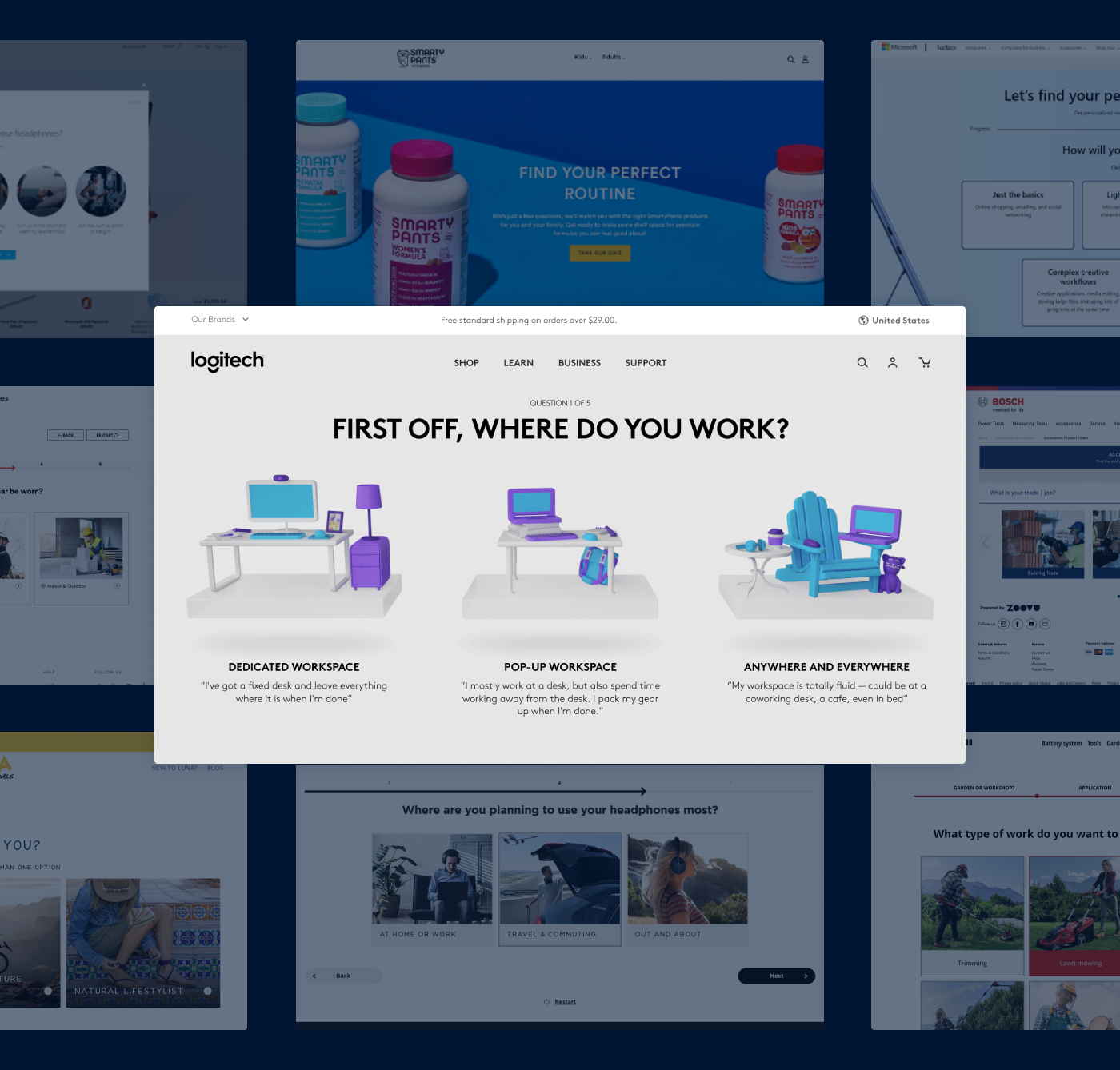Understanding Guided Selling
Customers want personalized interactions, proactive service, and sales reps who understand their needs.
In fact, 66% of consumers surveyed in a Salesforce State of the Connected Customer survey expected businesses to understand their needs in the sales process.
Therefore, it’s increasingly important that your brand blends quality messaging and personalization with a meaningful branded buying process.
Guided selling assists you with providing a smooth, personalized online shopping experience that builds consumer trust and loyalty. Through a series of questions and machine learning algorithms, it helps customers with their decision-making process by providing specific product recommendations.
In this guide, we’ll share many real-world B2B and B2C guided selling examples so that you can clearly see the powerful benefits of a guided selling process in ecommerce.
Importance of Guided Selling in Ecommerce Sales
Guided selling in ecommerce helps provide the feel of an in-person experience at a brick-and-mortar store. It leverages AI technology to allow for more two-way conversations and interactions, so customers can efficiently get the information they need.
When done well, it feels like an exchange — polite, informative, and focused on their needs. As a result, it can build purchase confidence, increase conversions rates, improve customer satisfaction, and because customers find what they need, reduce returns, and help you build a long-term customer relationship.
Guided Selling in B2B Sales
B2B guided selling aims to augment and digitize your sales team, providing best-fit product recommendations while customers shop independently online. For some B2B ecommerce sites, these discovery experiences generate direct sales, while others implement guided selling tools to capture and qualify lead information to later empower a salesperson to build a relationship and generate sales.
B2B sales teams also can use AI tools to collect data at scale and gain a comprehensive view and understanding of their pipeline and sales activities.
Guided Selling in B2C Sales
Guided selling in B2C follows the same needs-based question approach, which some businesses design as online questionnaires and quizzes to help funnel consumers to the right products.
Customers enjoy engaging with these types of guided selling experiences and can improve the customer’s overall preference for your brand, making them more likely to buy and be a returning customer. These tools are also available 24/7, so customers can always get the support and help they need, no matter the time.
This in turn leads to increased buyer confidence, improved customer satisfaction and lower refunds/returns.
Benefits of Guided Selling for Ecommerce
In ecommerce, businesses often struggle with challenges like abandoned carts, difficulty making product decisions due to too many choices, less meaningful customer engagement, and high return rates.
But guided selling for ecommerce is like having a personal shopping assistant available 24/7 to guide, support, and advise customers on their shopping journey. As a result, you can provide a smooth, memorable customer experience that increases conversions, reduces return rates, and builds customer trust and loyalty.
Personalized Experiences
Consumers want an efficient, personalized online shopping experience, especially when faced with lots of options or complicated purchases. Guided selling can answer customers’ questions and provide product recommendations tailored to their wants and needs. This experience can increase customer satisfaction, increase conversion rates, and reduce cart abandonment.
Reducing Customer Uncertainty and Analysis Paralysis
Shopping online can result in consumers facing a wide array of choices. While that can be good, it also can lead to decision fatigue, overwhelm, and uncertainty. As a result, consumers may stop looking and never make the purchase.
But guided selling helps to reduce customers’ uncertainty and helps them make a decision by providing information and guidance toward products that fit their needs. They end up having a pleasant online experience and are less likely to experience buyer’s remorse.
Cross-Selling and Upselling Opportunities
Guided selling can also provide suggestions and recommendations to shoppers about related items, increasing cross-selling opportunities. For instance, a customer buying a mattress online may benefit from seeing recommendations for pillows, mattress pads, and sheets.
You also can increase upselling opportunities by showing more premium options or items that may fit the customer’s needs. This makes it easier for them to compare their choices and helps them select the product that best fits what they want, improving their customer satisfaction.
Live Examples
When properly implemented, guided selling helps consumers find the products they need while experiencing an efficient, personalized buying journey. It helps ecommerce businesses increase sales, build brand trust, and engage customers in more meaningful exchanges.
Here are some real-world examples of ecommerce businesses effectively using guided selling to enhance their customers’ experiences.
3 Ecommerce Website Examples
Technology: Microsoft
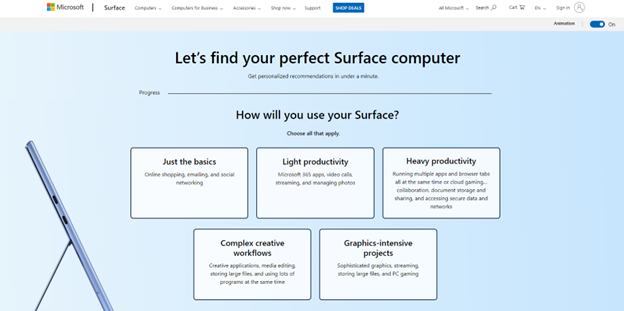
Buying computer products can feel overwhelming quickly since there are so many choices and options for consumers to consider. Microsoft helps minimize decision fatigue and guides shoppers to the best-fit product through the use of their AI-guided selling tool.
This web page is a great example of leveraging AI technology to provide a personalized, easy shopping experience because it:
- Is easy to use, providing clear choices that fit their customers
- Provides a visual tool to track progress through the guide, plus estimates the amount of time it takes to complete the task
- Can be completed quickly (less than a minute)
- Is visually appealing and on brand
Customers who use this tool will also have increased confidence that they selected the right Surface computer and options for them, which can reduce buyer’s remorse and returns. This tool also shows customers that Microsoft cares and is finding ways to make shopping with them fun and easy, which can increase customer satisfaction and loyalty.
Health and Wellness: SmartyPants
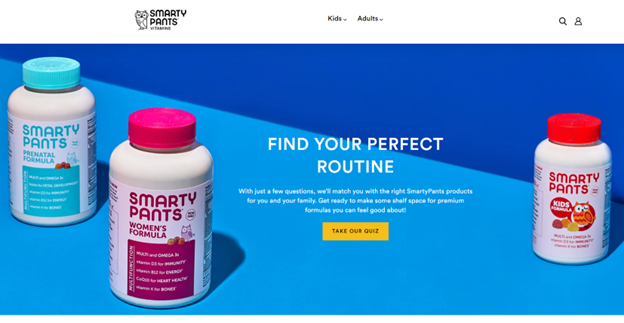
SmartyPants provides a short quiz to help shoppers identify the right product. This approach is especially beneficial for new customers who aren’t certain about what they really want or need.
This quiz works because it:
- Asks for only information it really needs
- Is short
- Provides a tracker at the top of what question the customer is on
- Gives clear choices to select from, showing customers the brand understands their needs
- Uses relevant images for most questions, making it more visually appealing
- Makes use of cross-selling opportunities (for example, a mom shopping for herself will also be lead to additional questions about her child, resulting in recommendations for her and her child)
At the end of the quiz, shoppers are provided with several product choices, which they can click on to receive more information. This approach streamlines the shopping experience, helping customers to focus quickly on items that will suit their needs. This helps to reduce returns, build purchase confidence, and increase customer satisfaction.
Apparel: Luna Sandals
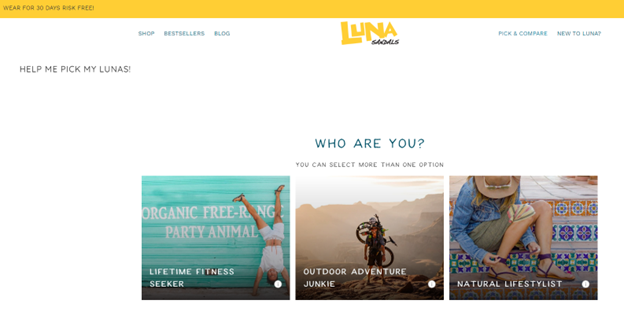
Shopping online for shoes is challenging, especially if you’re new to the brand or looking for a different type of shoe. Customers have to make decisions about the fit, feel, and how well the shoe will meet their needs based only on descriptions instead of being able to try shoes on in a store.
Luna Sandals makes this process easier by providing a quiz to help customers identify which sandals will best fit their needs.
This quiz works because it:
- Provides choices that fit their different types of customers
- Is engaging and on brand, with fun and colorful images and easy-to-read text
- Shows how many questions the customer has answered and how many are left
- Makes it easy to get more information about options without leaving the page (i.e., hover over the ‘i’ on the image)
- Is easy to go back to an earlier question if the customer wants to change an answer
After completing the quiz, the shopper receives several options with the information about the different products directly included on the page (no extra clicking needed). Shoppers can also select the Compare button to help them narrow down the choices or go to the full product page.
This quiz helps to build a shopper’s purchase confidence, reduce decision fatigue, and streamline the shopping experience, leaving customers satisfied with their choice and reducing the chance of buyer’s remorse.
Looking to create an AI-guided selling experience similar to Ring? Check out Zoovu’s product discovery platform.
Real-World Success Stories
Here are some additional examples how Zoovu customers are using AI-guided selling in both B2B and B2C environments.
Guided Selling Examples For B2C
Microsoft
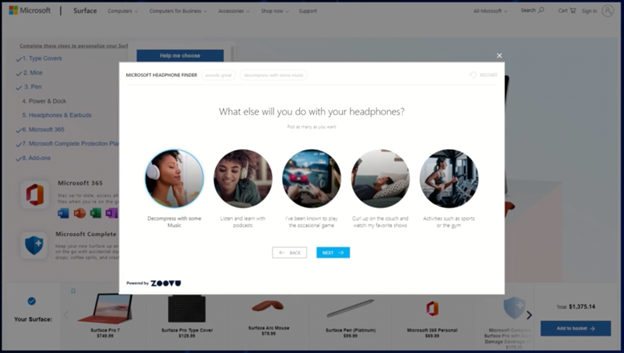
With a commitment to transforming how people work, play, and communicate, Microsoft identified a challenge in the digital buying journey. As customers increasingly turned to digital channels for research and purchases, many faced “choice paralysis” due to the broad range of Microsoft products. This not only affected the customer experience but also impacted sales for Microsoft’s channel partners. To address this, Microsoft sought to provide a more guided and effective buying experience for both customers and retail partners.
Leveraging Zoovu’s AI Discovery Platform, Microsoft translated technical product specifications into a needs-oriented language. This transformation led to the creation of 250+ live omnichannel discovery experiences, which educated and guided customers, facilitating easy product customization and bundling. Microsoft also utilized Zoovu’s in-platform auto-translations.
By collaborating closely with its extensive network of retail partners, Microsoft integrated these digital sales experiences on partner websites. This resulted in a 30x return on investment and a 90% increase in engagement.
Canon
Canon Europe, the EMEA branch of Canon, Inc., operates in 120 countries and contributes approximately a third of Canon’s global revenue. Collaborating with Zoovu since 2011, Canon aimed to provide its diverse audience with a seamless product discovery experience. Their goal was not just to sell any product but to ensure that each shopper found the perfect product tailored to their needs. This approach was intended to educate and inspire customers early in their buying journey. Canon integrated conversational assistants on its brand websites across various product categories, including printers, scanners, cameras, and lenses.
With Zoovu’s assistance, Canon swiftly implemented product search and discovery experiences across 52 countries, which led to a 53% increase in conversion and a 14% increase in revenue.
Bosch
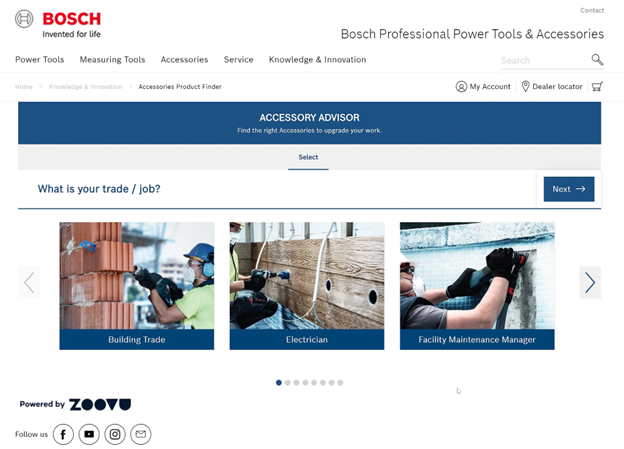
Bosch Power Tools, a leading division of the Bosch Group, encountered difficulties in guiding online customers through their extensive product portfolio. With more than 10k products and accessories, this made it challenging for customers to identify the right tools for their needs. Recognizing the importance of a seamless customer experience, Bosch turned to Zoovu’s Semantic Studio. This transformed complex technical product specifications into customer-friendly language. Leveraging this, Bosch developed 46 live AI assistants across 36 countries that use simple questions to guide buyers to the most suitable power tools and accessories. As a testament to its effectiveness, Bosch expanded this enhanced user guidance system, including the “Bosch Accessory Advisor,” across 36 of its primary markets, emphasizing the company’s commitment to fostering an authentic, customer-first relationship.
Guided Selling Examples For B2B
3M
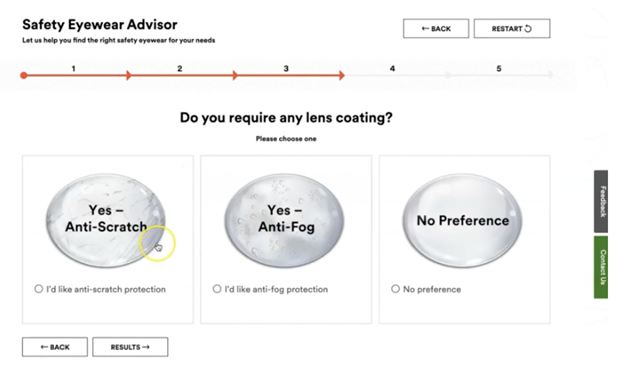
As the company’s buyers increasingly shifted towards digital channels, 3M recognized the importance of providing self-service purchasing experiences that were both reliable and compliant with industry-specific safety policies and regulations. Before collaborating with Zoovu, 3M’s approach to organizing product data was labor-intensive and inefficient, relying on third-party specialists to manually transfer product content from PDFs into spreadsheets.
To address these challenges, 3M employed Zoovu to automate and enhance the digital sales experience by creating 65+ live selling assistants. This allowed buyers to identify and purchase essential products without the need for direct interaction with a sales representative. Zoovu’s semantic content enrichment capabilities enabled buyers to understand various SKUs and select products based on usage and risk management criteria. Furthermore, 3M utilized Zoovu’s Semantic Studio to replace the expensive and time-consuming process of hiring third-party specialists for product data tagging. This AI-powered solution automated data management tasks and generated conversational product content that aligned with how buyers searched for products. As a result, this led to a 2x increase in conversions for 3M and an improved buyer experience.
Einhell
As the digital shift became more pronounced, Einhell recognized the need to provide a trustworthy self-service buying experience. Their innovative Power X-Change battery system eliminated the confusion of using different batteries for various tools and garden equipment. However, the challenge lay in effectively communicating the benefits of this system and ensuring customers could easily find the right product combinations.
To tackle this, Einhell partnered with Zoovu to automate the digital sales experience. They integrated product data into Zoovu, transforming technical specifications into customer-friendly language. This led to the creation of conversational assistants and product configurators, enabling buyers to discover the right power tools and accessories. The implementation was swift, going live in just four weeks.
As a result, Einhell witnessed a 60% sales increase within three months, attributing this growth to customers’ ability to discover the perfect product combinations for their needs. Beyond sales, Einhell also gained valuable insights into customer behavior, preferences, and purchasing trends.
Guided Selling with Visual Configurators
Images and interactive visuals can help buyers better understand products’ options, abilities, and help them visualize their purchase, which can drive sales.
Visual configurators are a kind of online tool that lets customers view products, interact, and customize them based on their personal preferences. Essentially, it allows shoppers to see what the product will look like when they select certain features, like color, configurations or accessories.
Logitech worked with Zoovu to create a unique visual experience combining guided selling and visual configuration. By asking about the customer’s workspace and preferences, the guided selling part helps pinpoint what they need. The visual configuration then lets them see how their ideal computer setup would look.
This approach achieves two things:
- It suggests products that cater specifically to the customer’s needs.
- It introduces matching accessories that complement the main products.
Using this tool, customers feel more confident in their choices and appreciate the personalized shopping experience it offers.
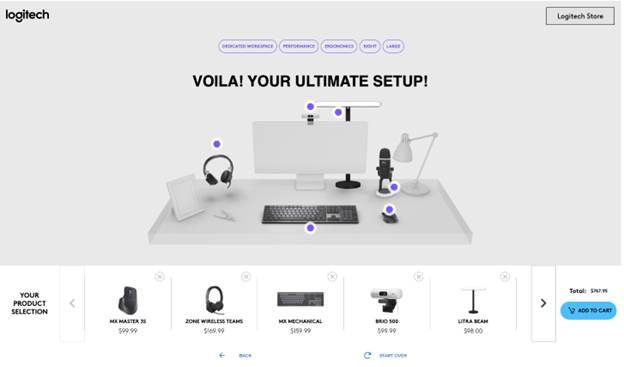
Interested in offering your customers an interactive 3D shopping experience? Check out Zoovu’s Visual Configurators.
Encouraging Customer Engagement
Visual product configurators get shoppers interacting and engaging with products, which can help move them further through the buyer’s journey. It allows them to see how the different options impact the product, so they can decide on what they want while having increased confidence that they’re making the right choice for them. They’re also more likely to remember your products since they interacted with the visual elements.
Allowing Customers to Customize Products
Visual configurators also let customers customize products, so they can tailor items to better fit their needs, aesthetic, and wants. It also allows them a visual of the item so they don’t have to see the customized product in-person before purchasing. It can also build excitement for the item since they can see exactly what they’re getting.
Real-Time Visualizations and Virtual Mock-Ups
Visual configurators streamline the shopping experience since customers can see the changes and options in real time. For instance, they can immediately see what a shirt will look like in different colors.
If you’re using a 3D product visualization tool you can also provide a 360-degree view of the item from every angle. This tool can be helpful when it’s important for people to get a sense of how something will look in their home, office, or personal space.
Product configurators that incorporate augmented reality can allow people to project a model of the item in their space, so they can see what it would look like in their home. This type of visual configurator can help increase customer satisfaction, decrease buyer’s remorse, and increase purchasing confidence.
Interactive Guided Selling Tools and Their Impact on Ecommerce
Interactive guided selling tools are revolutionizing the ecommerce landscape by catering precisely to customer needs. These tools streamline the sales process, making it more efficient and customer-centric. By asking a series of targeted questions, these tools can pinpoint customer preferences and offer product recommendations that align perfectly with their needs.
Enhancing Customer Experience through Personalized Interactions
A key aspect of guided selling tools is their ability to enhance the overall customer experience. By integrating these tools into the ecommerce platform, businesses can ensure that customers feel understood and valued. This personalized interaction not only improves customer satisfaction but also boosts conversion rates by making purchasing decisions easier and more informed.
Leveraging Data-Driven Insights for Effective Sales Strategies
Guided selling tools are instrumental in collecting valuable customer data. This data-driven approach allows businesses to refine their sales strategies in real-time, ensuring that they are always aligned with customer preferences and market demands. Moreover, this wealth of data can help in crafting targeted marketing strategies that speak directly to the customer’s unique needs and preferences.
Automation in the Sales Process: Enhancing Efficiency and Accuracy
The integration of automation within guided selling tools helps in reducing manual efforts and minimizing errors in the sales process. From automating product recommendations to configuring complex product options, these tools ensure a seamless buying journey. Automation also helps in managing large volumes of transactions, which is particularly beneficial for B2B sales where the sales cycles are longer and more complex.
Expanding Sales Enablement through CPQ (Configure, Price, Quote) Software
CPQ software is another facet of guided selling that plays a crucial role in B2B environments. This software simplifies the quoting process by allowing sales representatives to quickly configure products and services according to customer requirements. It also automates the pricing and quoting process, enabling sales teams to deliver accurate and timely proposals to their clients.
Boosting Sales Through Cross-Selling and Upselling Opportunities
Guided selling tools excel in identifying cross-selling and upselling opportunities. By understanding the customer’s primary purchase, these tools can suggest additional products that complement or enhance the main product. This not only increases the average order value but also improves customer satisfaction by providing them with a complete solution.
Real-Time Adaptation and Decision-Making Enhancements
The ability to adapt in real-time is a significant advantage of using AI-driven guided selling tools. These tools can adjust the sales approach based on customer interactions and feedback, ensuring that the sales strategies are always optimized for the best results. Furthermore, the incorporation of AI helps in refining the decision-making process, making it quicker and more efficient.
Streamlining Complex Product Offerings through Guided Selling
For industries dealing with complex product offerings, guided selling can simplify the buying experience dramatically. By guiding customers through a customized buying journey, these tools help in demystifying complex product specifications and configurations, making it easier for customers to understand and choose products that meet their specific needs.
Enhancing Customer Relationships with Personalized Follow-ups
Guided selling tools also facilitate stronger customer relationships through personalized follow-up interactions. By leveraging customer data collected during the initial sales process, businesses can create follow-up communications that are tailored to each customer’s unique preferences and previous interactions. This personalized approach not only enhances customer loyalty but also increases the chances of repeat purchases.
Achieving success and scalability in Digital Sales relies on providing outstanding customer experiences.
These exceptional experiences can only be achieved by using clean and enriched intelligent product data.
Zoovu’s Platform combines the necessary components for successful digital sales, including Product Data Cleaning & Enrichment, alongside AI-powered digital sales experiences tailored for B2B and B2C Buyers.
